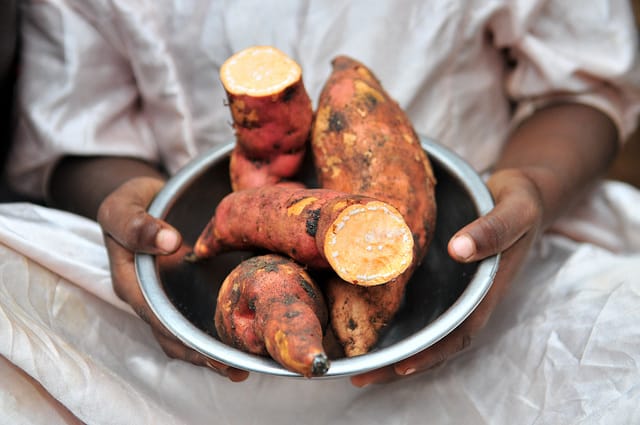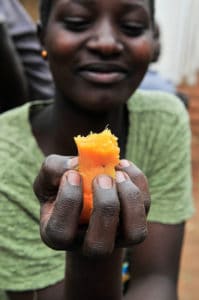Big Data to the rescue for cassava disease monitoring in Uganda
Quick disease monitoring and diagnosis of tubers, due to the limited number of experts and resources to cover the entire country, has been a problem for Uganda. How can big data solve this?

Photo by Neil Palmer / CIAT
The sight of the huge freshly roasted tubers by the roadside along the Kampala-Gulu highway is quite odd to the uninitiated.
Their behemoth size; at times the diameter of a male forearm can be overwhelming to behold, let alone eat.
However, for the price of less than a third a US dollar, it is not easy to suppress the temptation to buy one, even just for curiosity’s sake.
A short bite into the crusty exterior leads you into the belly of the tuber; still warm from the fire, the soft starchy innards soon turn sweet as they dissolve with every chewing motion. A few bites in and you’ll surely need a drink to wash down all that starch.
Unfortunately, this rosy culinary picture is being severely affected by a host of diseases ravaging cassava plantations of smallholder farmers who still grow the indigenous variety of the crop.
Wikipedia classifies the diseases affecting cassava as; bacterial, fungal, oomycete, miscellaneous diseases and disorders as well as viral and phytoplasma.
In Uganda, the crop is being affected by diseases such as cassava bacterial blight, cassava mosaic disease, cassava brown streak disease among others.

Photo by Neil Palmer / CIAT
Thanks to its drought resistance and high starch content, cassava has been identified as a high-value crop and as such ranks high in priority on the research agenda of bodies such as the National Crop Resources Research Institute (NaCRRI). NaCRRI monitors the incidence of diseases affecting cassava through annual national surveys, which are unfortunately manual.
These generate a lot of data, which has to be subsequently cleaned, processed and analysed before reports are written.
These processes demand a lot of man-hours and inadvertently lead to a lot of inaccuracies at each stage.
In 2015 while attending a Research Dissemination Seminar organised by the Directorate of Research and Graduate Training of Makerere University, my ears were tickled by a presentation by Mr. Grace Kamulegeya on semi-automated procedures used to sort, filter and clean a large image dataset from a NaCRRI survey with the aid of artificial intelligence.
Kamulegeya and his colleagues had relied on methodologies of handling big data to conduct activities like automated disease severity scoring for datasets of over 25,000 images.
He hoped that their work would form the basis for the provision of timely, appropriately presented data from a crowd-sourced mobile-phone based system of disease surveillance.
Intrigued by this knowledge, I sought to further discover if an application had been developed to fast-track disease surveillance and, to my pleasure, one indeed existed!
In 2011, John A. Quinn, Kevin Leyton-Brown and Ernest Mwebaze had published a paper on Modeling and Monitoring Crop Disease in Developing Countries. In this paper, the researchers reported that they had developed a mobile survey system that was then being applied in field trials in partnership NACRRI.
For each plant being surveyed, the system collected not only an expert diagnosis, leaf image but also GPS coordinates.
The system additionally employs computer vision techniques that use camera-enabled mobile devices to make disease diagnoses.
This means that even workers with lower levels of training can be deployed to carry out disease surveillance, hence eliminating the need for experts and the associated costs they bring.
Big Data is, therefore, going to provide the lifeline for quick disease monitoring and diagnosis in Uganda where previously, the limited number of experts, as well as resources to cover the entire country, has been a problem.
By relying on up-to-date information that is constantly being updated thanks to the continued proliferation of smartphones and crowd-sourcing, smallholder farmers; who make up 89% of the population, can potentially be saved from crop disease-associated loss by the advent of big data.
Finally, government bodies such as NaCRRI will now be better equipped to monitor the resistance of new crop varieties to disease and prioritise their distribution of improved planting materials, based on the severity of disease incidence.
Wamai Nabende Mark
Mark is in charge of Web Management in the Public Relations Office of East Africa’s flagship Higher Education Institution, Makerere University. He is passionate about writing and is intrigued by the potential of technology to unlock the productivity and profitability of smallholder farmers in Uganda and Africa.
Blog Competition Entry
This article is published as a part of our publicly open big data blog competition. If you have enjoyed this reading this entry, you can vote by liking, commenting or sharing.





Comment
Nice piece, there is lots of work awaiting breeders, extension, and in handling Post harvest losses to meet food demand by 2050,
good work
Thank you Rexton. A lot of information from the breeders, extension workers and researchers exists out there. Big Data offers a solution to be able to make meaningful sense of it all in time to influence decision making and enhance productivity by 2050.
you are doing goodwork out there,preparing in advance before 2050 is one of the shield we need to prevent malnutrition More so in Africa,kudos.
Thank you Peter. Africa has the potential to not only survive malnutrition but also thrive thereafter.